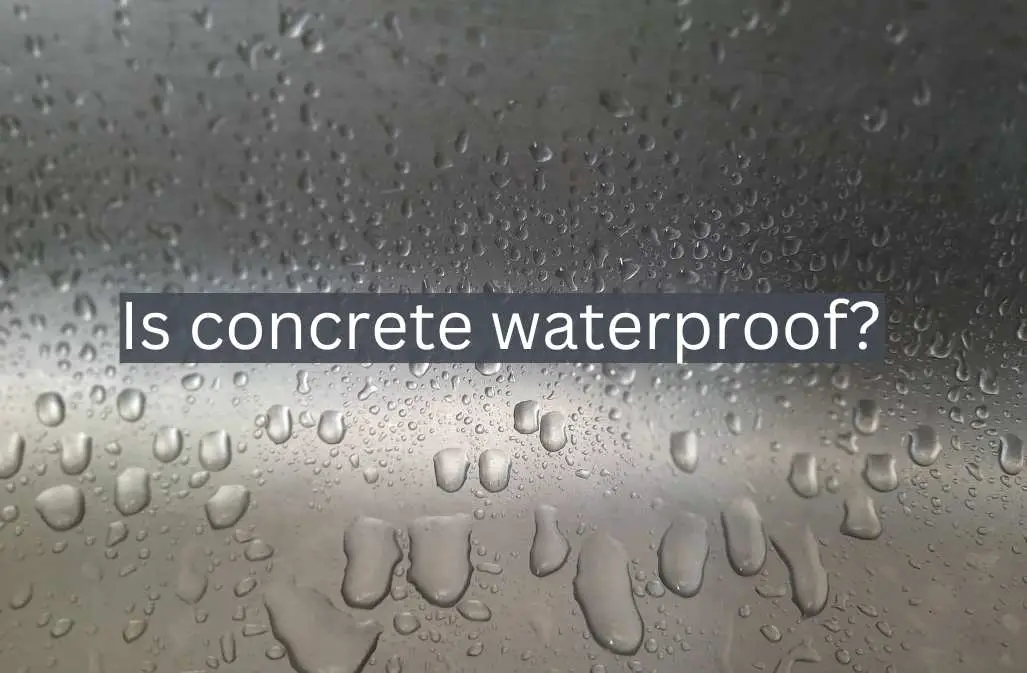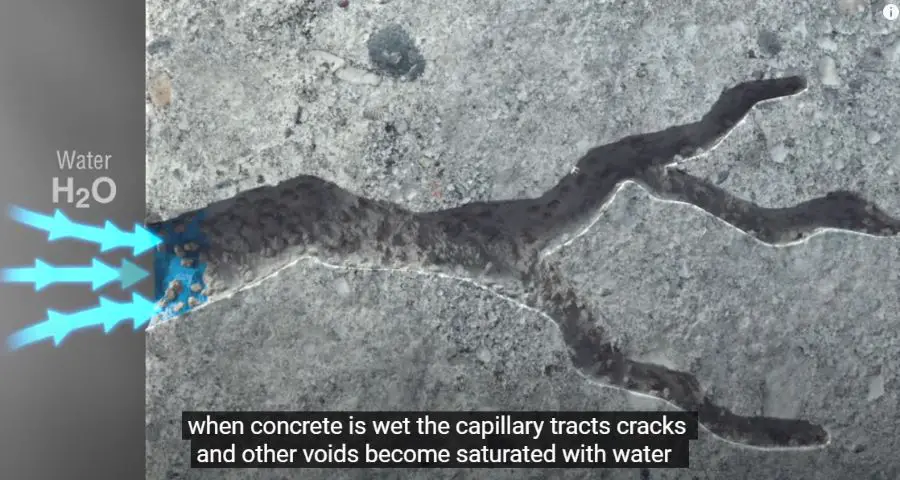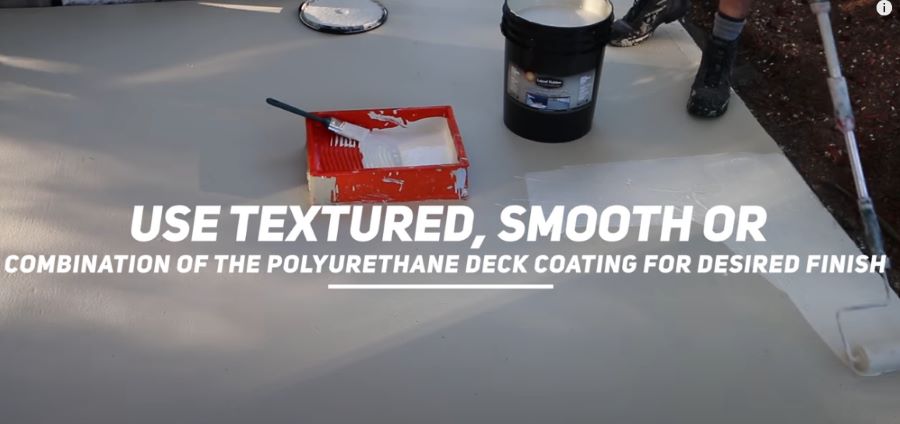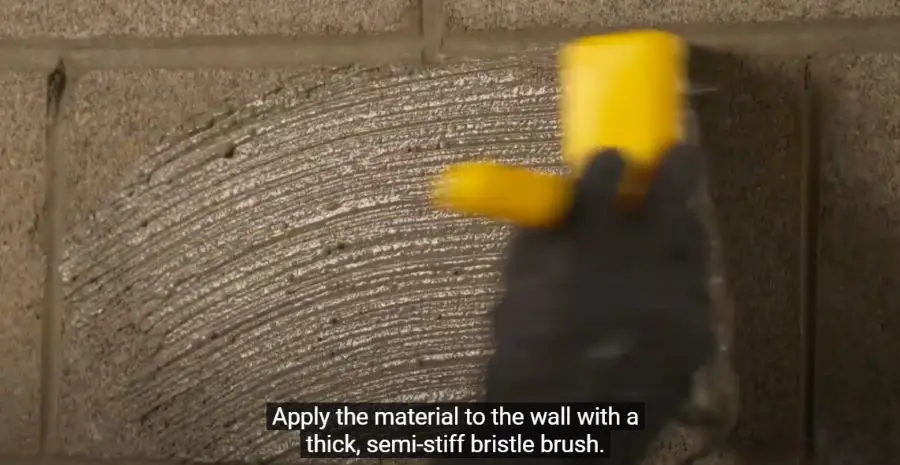Is concrete waterproof? how to make concrete waterproof

Concrete is not inherently waterproof, but it can be made to be water-resistant or waterproof through the use of additives, coatings, or sealants.
When concrete is mixed, water is added to the mix in order to activate the cement, which then binds the other components together to form a solid structure.
However, this mix can be porous, which means that water can pass through it and potentially cause damage over time.
To make concrete more waterproof, various additives can be included in the mix. For example, waterproofing admixtures can be added to the concrete mix to reduce its porosity and improve its ability to resist water penetration.
Coatings and sealants can also be applied to the surface of the concrete to create a barrier that prevents water from seeping through.
It's important to note that even with these measures in place, concrete is not completely impervious to water.
If water is able to find a way through cracks or other imperfections in the concrete, it can still cause damage over time.
So while concrete can be made waterproof, it's still important to take steps to ensure that it remains in good condition and free from damage.
how do you make concrete waterproof?
1. By using admixtures in the concrete mix
Concrete admixtures can be used to improve the waterproofing properties of concrete.
Admixtures are chemical compounds that are added to the concrete mix during mixing to modify its properties.
Waterproofing admixtures can be used to reduce the permeability of concrete and make it more resistant to water penetration.
These admixtures can be in the form of powder, liquid, or a combination of both, and they work by filling the capillary voids and pores in the concrete to make it more compact and dense.
There are several types of waterproofing admixtures that can be used for concrete, including crystalline admixtures, hydrophobic pore-blocking admixtures, and water-reducing admixtures.
- Crystalline admixtures work by forming water-insoluble crystals within the concrete, which can block the capillary voids and prevent water from passing through.
- Hydrophobic pore-blocking admixtures work by forming a hydrophobic layer around the concrete particles, which repels water and prevents it from entering the concrete.
- Water-reducing admixtures, on the other hand, reduce the amount of water needed in the mix and can also improve the density and strength of the concrete.
It's important to note that while admixtures can improve the waterproofing properties of concrete, they may not make it completely waterproof.
Other measures such as surface coatings or sealants may also be necessary for additional protection against water penetration.

2. Concrete sealers and surface coatings
There are several types of surface coatings and sealants that can be used to make concrete waterproof, including:
- Acrylic coatings: These coatings are water-based and provide a protective film on the surface of the concrete. They can be applied by spray, brush, or roller and are relatively easy to apply. They can provide a glossy or matte finish and come in various colors.
- Epoxy coatings: These coatings are made of a two-part resin and hardener that are mixed together before application. They provide a tough and durable surface that is highly resistant to water penetration. Epoxy coatings can be used in a wide range of environments, including industrial, commercial, and residential settings.
- Polyurethane coatings: These coatings are highly resistant to water, chemicals, and abrasion. They can be applied as a clear or pigmented coating and can provide a glossy or matte finish. They are commonly used for waterproofing floors, decks, and roofs.
- Silane and siloxane sealers: These sealers penetrate the surface of the concrete to create a hydrophobic barrier that repels water. They can be applied to both new and existing concrete and are ideal for use on horizontal surfaces such as driveways, patios, and sidewalks.
- Penetrating sealers: These sealers penetrate into the pores of the concrete to create a barrier that blocks water penetration. They do not change the appearance of the concrete and are ideal for use on vertical surfaces such as walls and retaining walls.
It's important to note that surface coatings and sealants should be applied to clean and properly prepared concrete surfaces for the best results. Additionally, it's important to choose a product that is appropriate for the specific application and environment in which it will be used.
Why can water pass through concrete?

Concrete is not normally waterproof due to its inherent porosity and permeability.
When concrete is mixed, water is added to the mix to activate the cement and bind the other components together.
However, as the concrete mix cures and the mix water evaporates, it leaves behind a matrix of tiny little pores.
The fully cured or hardened mix is now very porous, which means that water can penetrate through the material and potentially cause damage over time.
In addition, the aggregates used in concrete can also contain small voids and pores that can contribute to the permeability of the concrete.
Another factor that can contribute to the porosity of concrete is the curing process. If the concrete is not properly cured, it can be more susceptible to cracking and other types of damage that can allow water to penetrate through the material.
how to make concrete more dense and less permeable
There are several ways to make concrete more dense and less permeable, including:
- Reduce water content: When the water content in the concrete mix is reduced, the resulting mixture will have a lower porosity and will be more dense. This can be achieved by using a lower water-to-cement ratio or by using a water-reducing admixture.
- Increase cement content: Adding more cement to the mix can help to reduce the porosity of the concrete and make it more dense. However, increasing the cement content can also increase the cost of the concrete.
- Use smaller aggregates: Using smaller aggregates, such as sand, can help to reduce the porosity of the concrete and make it more dense. Smaller aggregates also provide a tighter packing of particles, which can help to reduce voids and capillaries.
- Use admixtures: Admixtures such as pozzolans, fly ash, or silica fume can be used to reduce the porosity of the concrete and make it more dense. These admixtures react with the calcium hydroxide in the cement to produce additional cementitious material, which can help to reduce the size of the pores in the concrete.
- Use densifiers: Densifiers such as sodium silicate or lithium silicate can be applied to the surface of the concrete to react with the free lime and calcium hydroxide in the concrete. This reaction produces a gel that fills the pores and capillaries in the concrete, making it more dense and less permeable.
It's important to note that while these measures can help to make concrete more dense and less permeable, they may not make it completely waterproof. Additional measures such as surface coatings or sealants may also be necessary for additional protection against water penetration.
What can you add to a concrete mix to waterproof it?
Xypex is a special chemical that can help make concrete waterproof and better protected.
It comes in a product called Xypex Admix C-1000/C-1000 NF which is mixed with the concrete when it is being made.
This special mix contains different materials like cement, sand, and some secret ingredients. When Xypex Admix is mixed with the concrete, it reacts with the moisture and other things in the concrete.
This causes a special kind of crystal to form inside the concrete, which blocks up all the tiny holes and spaces inside the cured concrete.
The crystals make a barrier that water and other liquids cannot get through. This way, the concrete will stay safe and dry for a long time.
Waterproofing the surface: various types of concrete waterproofing materials and applications
1. POLYURETHANE - is a really good material for making concrete waterproof. It can be rolled or sprayed on seamless and goes deep into the concrete, which makes it really good at stopping water from getting through.
It's also really strong and can resist things like oil and detergents, which is great. It's good for all sorts of things like walls, balconies, and terraces. But, it can be a little more expensive than other materials. The price is usually around $10 for every square meter of the building.

To waterproof concrete with polyurethane, follow these general steps:
- Clean and prepare the surface: The surface of the concrete should be clean and free of any dirt, debris, or other contaminants. Use a pressure washer or a stiff-bristled brush to clean the surface and allow it to dry completely.
- Apply a primer: A primer may be necessary to improve the adhesion of the polyurethane to the concrete. Apply the primer to the surface of the concrete and allow it to dry completely before applying the polyurethane.
- Apply the polyurethane: Apply the polyurethane to the surface of the concrete using a sprayer, brush, or roller. Make sure to apply the polyurethane evenly and to cover the entire surface. Allow the first coat to dry according to the manufacturer's instructions.
- Apply additional coats: Depending on the level of waterproofing required, additional coats of polyurethane may be necessary. Apply each coat evenly and allow it to dry before applying the next coat.
- Inspect the surface: Once the final coat has dried, inspect the surface of the concrete for any missed areas or thin spots. Apply additional polyurethane as necessary to ensure that the surface is completely covered and waterproof.
It's important to follow the manufacturer's instructions for the specific polyurethane product being used, as the application process may vary depending on the product.
Additionally, it's important to properly prepare the concrete surface before applying the polyurethane, and to follow any safety precautions or recommendations provided by the manufacturer.
2. CEMENTITIOUS COATING - is a powerful combination of powder, sand, organic and inorganic materials, and silica-based substances. This incredible mixture has become the go-to solution for waterproofing contractors, as it is incredibly easy to apply.
Simply mix the powder with water in the right quantity, and the installation work can begin. While the downside of this benefit is the lack of flexibility, it is still one of the recommended waterproofing materials for basements and foundations.
One of the most remarkable benefits of cementitious coating is its affordability, with a cost of only $2 to $4 per square foot installed. With cementitious coating, you can trust that your property is safe from water damage, without breaking the bank.

To apply cementitious coating to waterproof concrete, follow these general steps:
- Clean and prepare the surface: The surface of the concrete should be clean and free of any dirt, debris, or other contaminants. Use a pressure washer or a stiff-bristled brush to clean the surface and allow it to dry completely.
- Mix the cementitious coating: Follow the manufacturer's instructions to mix the cementitious coating with water. Mix the coating to a smooth, lump-free consistency.
- Apply the coating: Apply the cementitious coating to the surface of the concrete using a brush, roller, or spray gun. Apply the coating evenly and make sure to cover the entire surface. Allow the first coat to dry according to the manufacturer's instructions.
- Apply additional coats: Depending on the level of waterproofing required, additional coats of cementitious coating may be necessary. Apply each coat evenly and allow it to dry before applying the next coat.
- Inspect the surface: Once the final coat has dried, inspect the surface of the concrete for any missed areas or thin spots. Apply additional coating as necessary to ensure that the surface is completely covered and waterproof.
It's important to follow the manufacturer's instructions for the specific cementitious coating product being used, as the application process may vary depending on the product.
Additionally, it's important to follow any safety precautions or recommendations provided by the manufacturer.
3. EPDM RUBBER - is a popular material used to waterproof concrete. It is a type of synthetic rubber made from a mixture of ethylene, propylene, and diene monomers, and is known for its durability and flexibility.
EPDM rubber can be used for a wide range of applications, including waterproofing concrete roofs, decks, and foundations.
It's key benefit is flexibility and it comes in two thicknesses: 45 mils and 60 mils
When used for concrete waterproofing, EPDM rubber is typically installed as a sheet membrane. The membrane is first applied to the surface of the concrete using an adhesive, and then sealed using either a tape or a liquid sealant.
EPDM rubber provides excellent waterproofing and can withstand exposure to the elements and UV radiation, making it a popular choice for outdoor applications.
On average, the cost of EPDM rubber ranges from $0.75 to $3.00 per square foot, depending on thickness of the material.
However, it's important to note that EPDM rubber can be relatively expensive compared to other waterproofing materials, and the installation process can be more complex.
4. HOT APPLIED RUBBERIZED ASPHALT MEMBRANE - is a type of waterproofing material that is commonly used for concrete structures such as roofs, decks, and foundations.
It is typically made from a blend of rubberized asphalt, high-grade polymers, and other materials, which are melted and applied to the surface of the concrete using a heated applicator.
The process of applying hot applied rubberized waterproof membrane typically involves the following steps:
- Surface preparation: The surface of the concrete must be cleaned and prepared before applying the membrane. This involves removing any debris, dirt, or contaminants and repairing any cracks or other surface defects.
- Heating the membrane: The membrane is typically supplied in a solid form and must be melted before it can be applied. This is done using a specialized heated applicator, which heats the membrane to the required temperature.
- Application: Once the membrane is melted, it is applied to the surface of the concrete using a squeegee. The membrane is spread evenly over the surface, with care taken to ensure that all cracks and other surface defects are completely filled.
Hot applied rubberized waterproof membrane is known for its durability and long lifespan, and is particularly effective in applications where the concrete is exposed to extreme weather conditions.
Watch the video below to see how hot rubberizes asphalt is applied to concrete.
5. THERMOPLASTIC - thermoplastic is a material that can be used to waterproof concrete in certain applications.
Thermoplastic is a type of plastic that can be heated and molded into various shapes, making it a versatile and flexible material that can be customized for different waterproofing needs.
One of the most common applications of thermoplastic for concrete waterproofing is in the form of sheet membranes.
These membranes are typically made from a blend of thermoplastic materials, including PVC (polyvinyl chloride) and TPO (thermoplastic olefin). The membranes are installed on the surface of the concrete and heat-welded together to create a continuous, waterproof barrier.
Thermoplastic sheet membranes offer a number of benefits for concrete waterproofing, including:
- Durability: Thermoplastic sheet membranes are known for their durability and resistance to water infiltration, making them ideal for applications where the concrete is exposed to moisture and other environmental conditions.
- Flexibility: Thermoplastic sheet membranes are flexible and can conform to the shape of the concrete, allowing for easy installation and a tight seal.
- Cost-effective: Thermoplastic sheet membranes are often less expensive than other types of waterproofing materials, making them an attractive option for budget-conscious projects.
- UV-resistant: Some types of thermoplastic sheet membranes are specifically designed to resist UV radiation, which can help to extend the lifespan of the waterproofing membrane.
Overall, thermoplastic sheet membranes can be an effective solution for waterproofing concrete in certain applications.
6. BITUMINOUS - bituminous materials can be used to waterproof concrete in various applications.
Bitumen is a viscous, tar-like substance that is a byproduct of crude oil refining, and can be modified with other materials to create different types of bituminous products for waterproofing.
Some of the most common bituminous materials used for concrete waterproofing include:
- Bituminous coatings: These are a type of liquid coating that can be applied to the surface of concrete to create a waterproof barrier. Bituminous coatings are typically made from a combination of bitumen and solvents, and can be applied using a brush, roller, or spray gun.
- Bituminous membranes: These are a type of sheet membrane made from a combination of bitumen and various reinforcing materials, such as polyester or fiberglass. The membrane is typically installed on the surface of the concrete using an adhesive, and can be heat-sealed to create a continuous, waterproof barrier.
- Built-up roofing: This is a type of roofing system that uses multiple layers of bituminous materials to create a waterproof barrier. The system typically includes a base layer of bitumen-coated felt, followed by multiple layers of bitumen and reinforcing materials.
Bituminous materials offer a number of benefits for concrete waterproofing, including:
- Durability: Bituminous materials are known for their durability and resistance to water infiltration, making them ideal for applications where the concrete is exposed to moisture and other environmental conditions.
- Flexibility: Some types of bituminous materials are flexible and can conform to the shape of the concrete, allowing for easy installation and a tight seal.
- Cost-effective: Bituminous materials are often less expensive than other types of waterproofing materials, making them an attractive option for budget-conscious projects.
For sure, bituminous materials can be an excellent solution for waterproofing concrete in certain applications.
frequently asked questions about concrete waterproofing: F.A.Q
Here are 10 frequently asked questions related to concrete waterproofing and their answers:
- What is concrete waterproofing? Concrete waterproofing is the process of applying a material to concrete surfaces to prevent water from penetrating and causing damage to the concrete or surrounding areas.
- How does concrete waterproofing work? Concrete waterproofing works by creating a barrier that prevents water from penetrating the surface of the concrete. This can be achieved through the use of various coatings, sealants, and membranes that are designed to resist water infiltration.
- What are the different types of materials used for concrete waterproofing? There are several types of materials used for concrete waterproofing, including coatings, sealants, membranes, and admixtures. Each material has its own unique properties and benefits, and the choice of material will depend on the specific application and requirements.
- Can all types of concrete be waterproofed? Most types of concrete can be waterproofed using the appropriate materials and installation techniques. However, some types of concrete may be more challenging to waterproof than others, such as porous or heavily textured surfaces.
- What are the benefits of concrete waterproofing? The benefits of concrete waterproofing include increased durability and lifespan of the concrete, protection against water damage and corrosion, and improved indoor air quality by preventing the growth of mold and mildew.
- How is concrete waterproofing installed? The installation process for concrete waterproofing will depend on the specific material being used. Some materials, such as coatings and sealants, can be applied using a brush or spray gun, while others, such as membranes, may require specialized equipment and installation techniques.
- How long does concrete waterproofing last? The lifespan of concrete waterproofing will depend on several factors, including the specific material used, the conditions in which it is installed, and the level of maintenance and upkeep. Generally, most waterproofing materials will last between 5-10 years, but some may last longer with proper care.
- Can concrete waterproofing be applied to existing concrete surfaces? Yes, most types of concrete waterproofing materials can be applied to existing concrete surfaces, provided the surface is properly prepared and any existing damage or defects are repaired before application.
- What is the cost of concrete waterproofing? The cost of concrete waterproofing will depend on several factors, including the size and complexity of the project, the type of material being used, and the level of installation difficulty. On average, the cost of concrete waterproofing ranges from $2 to $10 per square foot.
- What are some common applications for concrete waterproofing? Concrete waterproofing is commonly used in applications such as foundations, basements, roofs, decks, and parking structures, as well as in a variety of industrial and commercial settings where water infiltration is a concern.














